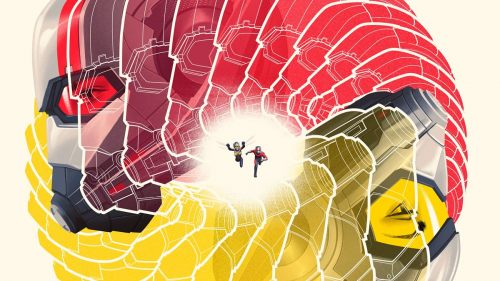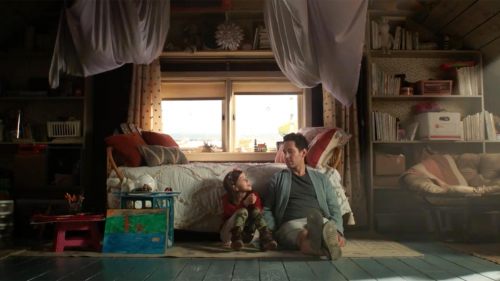Peyton Reed Goes Large With ANT-MAN AND THE WASP
Ant-Man and the Wasp is here! Get your tickets now!
Ant-Man and the Wasp plays like the movie Peyton Reed might have wanted to make as his Marvel debut. It unleashes Paul Rudd and goes wild with the size-changing concept central to the Ant-Man character – and the result is a confident Marvel comedy that doesn’t sacrifice its sense of the weird to the mainstream machine. We spoke to Reed at the Ant-Man and the Wasp press day, and talked about taking input from Rudd and Evangeline Lilly, and working with Walton Goggins.
Note: In this conversation we talk about a specific sequence that hasn’t shown up in trailers, so there’s minor spoiler talk ahead.
You got to develop the entirety of your movie this time!
Yeah! It was great. We had the burden of the origin story lifted, we’d already done that, so we could hit the ground running and develop the characters, and particularly Hope, or Wasp. We really designed how she moves and fights, from the ground up, and who she is as a hero.
How involved was Evangeline in determining Hope’s character?
Really involved, and I wanted her very involved. She does her work as an actress with very specific ideas, and thought a lot about the version of Hope in this movie as opposed to the Hope in the first movie. Now that she’s reconciled with her father and that family conflict is all behind her, how has that affected her general persona? She had very specific ideas that I fully credit Evangeline with, such as wanting Hope to be a kick-ass hero, and feminine, and strong, but also real. After a fight she wanted to have sweat on her. She didn’t want full makeup and flowing hair. She wanted the practical approach, and had thought a lot about very specific things that went into making Hope into a very real, dimensionalized character.
Even just seeing Evangeline today at the press conference, she clearly has very specific ideas that she communicates passionately.
And that’s a director’s gift. She comes at it with a really strong point of view. She feels a responsibility to the character and is protective of her. That is mirrored in who Hope is, and how she’s different from Scott Lang.
And then you’ve got Walton Goggins doing his thing.
I’ve loved Goggins since I first saw him in The Apostle, the Robert Duvall movie. I grew up in the South, in North Carolina, and thought Goggins was so authentically Southern in The Apostle. He’s great, and his career has taken off for good reason; he’s someone I’ve wanted to work with for a long time. You’ve seen him be intimitading, and you’ve seen him be hilarious. For what we were trying to do in this movie – basically stay in the crime genre and do something like “what if Elmore Leonard wrote a science fiction novel” – he seemed like the perfect guy. He can be a street-level antagonist who wants to take the next step up and rub shoulders with superheroes.
Given the concept you just described, and the combination of comedy and movement, I’ll admit I thought about Freebie and the Bean a lot while watching this movie.
Yeah, Freebie, and What’s Up Doc?, which we screened at Marvel for people who hadn’t seen it. The idea of the comedic chase was big for us, which in Doc was a riff on Bullitt, going through San Francisco and really building action sequences comedically.
Comedy is a big part of Marvel’s overall formula, if you want to put it that way, but comedy is really built in to this film at a genetic level.
That was something we wanted to do by design. I wanted to make this movie funnier than the first. In the first movie the onus was on setting up Paul Rudd as an action hero, and seeing if people would accept that. He hadn’t really done that before. So particularly in the first third of that movie, we had Paul playing more of a straight man, a little more laconic. He’s still Paul Rudd, he’s still funny, but other characters around him were more comedic. Now we’ve seen people embrace him in that way, so the idea was to let Rudd loose. Let’s have fun. We wanted to make it as densely funny as we could.
How did the balance of writing work? Rudd contributes to the script, but you’ve got Eric Sommers and Chris McKenna as primary writers.
Andrew Barrer and Gabriel Ferrari did the first drafts, then Eric and Chris came in, and Paul worked with them throughout all the stuff. It’s a combination. It was important to have Paul involved.
On the first movie Adam McKay and Paul had done the drafts after Edgar and Joe [Wright and Cornish] left. There was a lot of overhauling that we had to do. McKay and I, being Marvel fans since kids, wanted the Microverse as it was in the comics; so we did the Quantum Realm, which wasn’t ever in the movie. We wanted Janet alluded to, which wasn’t in it at that point. So it was important to me to have the continuity with Paul, because he was very involved in all that. And also because the Scott and Cassie Lang relationship is such a central dynamic in the movie, and it kind of mirrors Paul’s relationship with his daughter in a lot of ways. I like the authenticity of that.
At what point do you develop the idea of Paul Rudd channeling Michelle Pfeiffer?
That was one of the things that comes up when you’re sitting around taking about insane ideas and figuring out what you can get away with in the movie – basically “how Rick and Morty can we get with some of the concepts?”
We were dealing with heady things, like quantum entanglement. I didn’t want to make a movie that’s like setting up like a chalkboard to say “now we’re going to talk about quantum entanglement.” How do we visualize that concept, and maybe do it in a comedic way? The idea came up that Janet has left a psychic bread crumb in Scott’s head, and then it occurred to me – the concept reminded me of All of Me, where Lily Tomlin inhabits Steve Martin’s body. It seemed like a big swing, but if we could get away with it, the scene would be great. The insurance policy was Rudd, because we knew he could do it. But people were nervous about it.
That’s kind of a mold-breaking moment – there are 20 Marvel movies, so at some point it’s got to be difficult to come up with something that you’ve never seen in these films.
It’s fun to see it play out with an audience. They’ve got the tunnel working and we cut to Rudd, he’s tweaked, and some people get ahead of the bit. You can see them get excited for the idea, like “oh, it’s happening.” When Douglas says his line, it’s really a fun rolling thing. It’s not just how Rudd plays it, but how Michael and Evangeline play it.
Where Rudd is almost the straight man in the first film, here you’ve got Michael and Evangeline playing straight to him. Is that a natural dynamic?
It is, but it’s also something we tried to mix up. When Evangeline and I talked about Hope it was important that we wanted her to be a different persona in this movie, as I mentioned before. She’s frosty towards Scott at the beginning of the movie, but she has fun being a hero. We wanted to see the joy of finally getting the thing she trained for so long to do. Basically “I’m gonna fucking enjoy it!” That was important to see. She has some jokes, and even Douglas gets a few. I promised he wouldn’t always be the straight man, so you get that moment in the van outside the school.
You mentioned Rick and Morty, and we’re seeing projects that attune audiences to some pretty weird genre stuff. Do you have more leeway to go weird now, without the burden of explaining it all?
Absolutely, yeah. I think one of the things that makes Rick and Morty so popular is that you can take weird hard science concepts and make them funny and understandable, and always pivot left to defy expectations. And like you said, we’re the 20th Marvel movie! We have to do that, we want to, and audiences want it.
You get to be so much more playful with the core concept of changing size in this movie.
I had a whole list of gags, and because Marvel has a great internal visual development department I could go in and say like, “what if Scott uses a flatbed truck as a scooter?” I could throw them a rough sketch and two days later I get this beautiful digital painting.
There are a lot of those. A bunch made it into the movie, but there were a lot we didn’t have room for. If you look at the Art of Ant-Man and the Wasp book you’ll see a lot of those ideas, like Giant-Man making himself into a bridge between two cliffs with a Jeep driving over him. It was fun to come up with different uses of the size-changing stuff but they didn’t all fit.
On a film like this do you end up having to extensively vet every gag during development?
You can have the innate idea that a gag will work. But because the movie is so big, with location shooting and other moving parts, you want a visual proof of concept to explain it to different departments. So it’s great to have the pre-vis department do workshop those ideas. And that’s what having the longer prep time allowed for on this movie – to sit there and get it exactly right.



